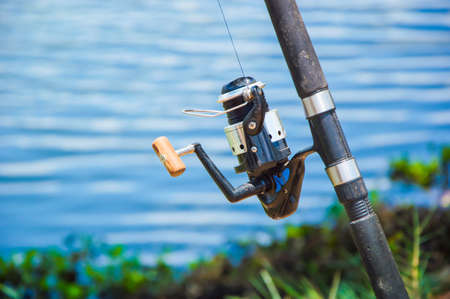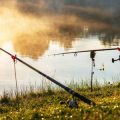Introduction to Baitcasting Rods
Baitcasting rods are a staple in the American angling scene, especially for those chasing after trophy bass or larger freshwater species. What sets these rods apart is their unique design, which pairs with a baitcasting reel mounted on top of the rod. This setup gives anglers more control and accuracy when casting heavier lures and targeting big fish. Unlike spinning rods, baitcasting rods are built to handle stronger lines and offer superior backbone, making them perfect for pulling lunkers out of heavy cover or deep water. Across the U.S., from Texas lakes to Florida swamps, seasoned anglers trust baitcasting combos for their power and precision. Whether youre flipping jigs under docks or tossing crankbaits along weed lines, a good baitcasting rod is an essential tool in any American bass fishermans arsenal.
Key Features to Look For in 2025
Choosing the right baitcasting rod for 2025 means staying updated with the latest tech and must-have features that can make or break your fishing experience. The American market is packed with options, but the best rods share some essential characteristics and cutting-edge innovations. Here’s a breakdown of what sets a top-tier baitcasting rod apart this year.
Must-Have Features for Modern Anglers
| Feature | Why It Matters |
|---|---|
| Sensitivity | Modern rods use advanced carbon blends to maximize feel, letting you detect even subtle bites on pressured waters. |
| Durability | Reinforced blanks and corrosion-resistant guides are critical for both freshwater and saltwater reliability. |
| Weight & Balance | Lighter rods reduce fatigue on all-day trips, while perfect balance improves casting accuracy and hooksets. |
| Handle Comfort | EVA foam and contoured cork grips provide comfort during long hours on the water, even in wet conditions. |
| Action & Power Options | Diverse action (fast, moderate) and power (medium-heavy, heavy) choices allow you to match your rod to different species and techniques. |
The Latest Tech Innovations for 2025
- Graphene-Infused Blanks: Expect lighter yet stronger rods thanks to graphene technology, offering increased sensitivity without sacrificing strength.
- Smart Reel Seats: Some new models integrate Bluetooth sensors for real-time cast analytics—perfect for tech-savvy anglers aiming to up their game.
- Tangle-Free Micro Guides: 2025 sees more rods with ultra-smooth micro guides that improve casting distance and reduce line friction, crucial for finesse presentations.
- Eco-Friendly Construction: Sustainable materials are trending as brands cater to environmentally conscious anglers without compromising performance.
What Sets the Best Apart?
A top-tier baitcasting rod in the US stands out through its combination of innovation, reliability, and angler-friendly design. American anglers often fish diverse environments—from clear bass lakes in Texas to heavy cover in Florida swamps—so versatility is key. Look for rods that offer a blend of premium materials, ergonomic design, and forward-thinking features tailored for local waters. When choosing your next rod, prioritize these advancements for an edge on every cast.

3. Expert Picks: Top Baitcasting Rods Reviewed
When it comes to baitcasting rods, American anglers demand gear that can handle tough conditions and deliver consistent results. Our expert team has tested the latest models for 2025, focusing on durability, casting distance, sensitivity, and real-life user feedback. Below are our honest reviews and direct comparisons of the top baitcasting rods you should consider this year.
St. Croix Bass X Casting Rod
Durability: The SCII carbon construction stands up to heavy use, whether you’re flipping jigs or tossing crankbaits.
Casting Distance: Delivers impressive distance thanks to its fast action tip.
Sensitivity: Sensitive enough to feel subtle bites in tough conditions.
User Experience: Anglers love its comfortable grip and reliable backbone—great for both weekend warriors and tournament pros.
Daiwa Tatula Elite Baitcasting Rod
Durability: Built with high-modulus graphite for extra strength without extra weight.
Casting Distance: TATULA’s precise guide placement means smooth, long casts even with lighter lures.
Sensitivity: Excellent strike detection; every vibration travels right into your hands.
User Experience: Known for its versatile performance across bass lakes from Texas to Michigan.
Abu Garcia Veracity Baitcasting Rod
Durability: 36-ton graphite blank resists wear and tear season after season.
Casting Distance: Smooth, accurate casting performance thanks to titanium alloy guides.
Sensitivity: Super-lightweight build enhances bite detection and hook-setting power.
User Experience: Popular choice among serious bass anglers who demand pro-level results.
Comparing the Best of 2025
If you need a rod that survives rough-and-tumble fishing trips, St. Croix takes the lead for toughness. Daiwa’s Tatula Elite excels if casting distance is your top priority, while Abu Garcia Veracity edges ahead in sensitivity and lightweight handling. All three have earned high marks from real users across the country, making them reliable picks for any American angler looking to step up their game in 2025.
Pro Tip
No matter which rod you choose, pair it with a quality reel and line matched to your target species and local water conditions for optimal performance out on the water.
4. Choosing the Right Baitcasting Rod for Your Fishing Style
When it comes to picking the best baitcasting rod, your fishing style and targeted species make all the difference. Whether you’re flipping for largemouth bass on Midwest rivers, pitching heavy jigs for northern pike, or chasing monster catfish in southern lakes, matching your rod to your technique is key. Here’s how to find the right fit:
Tailoring Your Rod to Your Technique
| Technique | Recommended Rod Action | Rod Power | Ideal Length |
|---|---|---|---|
| Bass Flipping/Pitching | Fast | Medium-Heavy to Heavy | 7’0”–7’6” |
| Pike Jigging | Moderate-Fast | Heavy | 6’8”–7’2” |
| Trophy Catfishing | Moderate | Extra Heavy | 7’6”–8’0” |
Rod Features That Matter Most
- Sensitivity: For detecting subtle bites, especially with soft plastics or finesse techniques.
- Backbone: Essential when hauling big fish from cover—look for strong lower sections.
- Handle Comfort: EVA foam or cork grips can make long sessions more comfortable—choose what feels best in your hand.
Baitcasting Rods by Region & Species
If you’re a southern angler targeting trophy bass, opt for longer rods with heavy power for extra casting distance and leverage. In northern states where pike lurk, a slightly shorter but stiffer rod helps with precision and control. For river anglers who love flipping and pitching around tight cover, fast-action rods allow for quick hook sets and accurate lure placement.
Your Personalized Pick: Match Your Gear to the Mission
The best baitcasting rod in 2025 is the one that fits both your hand and your favorite way to fish. Don’t be afraid to try several styles until you find that perfect blend of action, power, and length. The right rod will make every cast count—whether you’re working weed beds at sunrise or wrestling giants after dark.
5. Maintenance Tips for Longevity
When you invest in one of the best baitcasting rods of 2025, you want it to last through countless casts and catches. Proper maintenance is key to making sure your rod stays in top shape, season after season. Here’s some practical, field-tested advice every angler should know.
Clean After Every Trip
Dirt, salt, and fish slime can wear down even the toughest rods. After every fishing trip—whether you hit freshwater lakes or salty coastal waters—rinse your rod with fresh water. Use a soft cloth or sponge to wipe down the blank, guides, reel seat, and handle. For stubborn grime, a mild soap is fine, but be sure to rinse thoroughly. Always dry the rod completely before storage to prevent corrosion or mildew.
Inspect for Damage Regularly
Before and after each use, inspect your rod closely. Look for cracks, chips, or worn guide rings. Damaged guides can fray your line fast, while hidden cracks in the blank can lead to breakage right when you hook a trophy bass. Replace or repair parts as soon as you spot an issue—don’t risk losing a big catch because of neglected gear.
Store Your Rods Properly
Never leave your baitcasting rods leaning in a corner or locked in a hot car. Instead, use a dedicated rod rack that keeps them horizontal or upright without bending the blank or stressing the guides. If you’re storing rods long-term (like over winter), loosen the drag on your reels and remove them from the rods when possible. Keep everything in a cool, dry place out of direct sunlight to avoid UV damage.
Transport With Care
If you’re hauling gear to remote rivers or lakes, always transport your rods in protective cases or sleeves. This prevents accidental knocks and scratches whether you’re throwing them in the back of your truck or strapping them to an ATV.
Don’t Forget the Reel Seat and Handle
Baitcasting rods often feature cork or EVA handles that need attention too. Wipe down handles to remove sweat and debris—this keeps grip performance high and prolongs material life. Occasionally check reel seats for tightness; loose hardware can cause unnecessary wear over time.
With these outdoor-smart maintenance tips, your best baitcasting rod will stay reliable and ready whenever adventure calls.
6. Frequently Asked Questions
What kind of lures and lines work best with baitcasting rods?
Baitcasting rods are incredibly versatile, but they really shine with heavier lures and lines. Think crankbaits, spinnerbaits, Texas rigs, or swimbaits—anything that needs accurate placement and a little muscle. For line, most anglers in the U.S. prefer fluorocarbon or braided lines from 12 to 65 lb test, depending on your target species and cover. Monofilament can work too, but fluorocarbon’s sensitivity and abrasion resistance are tough to beat.
How do I break in a new baitcasting rod?
Breaking in a baitcasting rod isn’t complicated: start with moderate casts using lighter lures to get a feel for the blanks flex and action. Gradually increase lure weight and casting force over your first few outings. Always check your guides and reel seat for tightness before heading out—especially if you’re targeting bigger bass or fishing heavy cover.
Are baitcasting rods good for beginners?
Baitcasters have a learning curve, especially when it comes to managing backlash (the infamous “bird’s nest”). Still, many American anglers believe learning on a baitcaster is worth it for the accuracy and control you gain. Start with a rod in the 6’6” to 7’ range with medium-heavy power—it’s forgiving enough for new anglers but still delivers solid performance once your skills improve.
How do weather conditions affect baitcasting rod performance?
Cold weather can stiffen rod blanks and make some materials brittle—graphite rods are lighter but more sensitive to cold snaps, while fiberglass holds up better in freezing temps. Wet conditions mean slippery grips; look for rods with full-cork or EVA handles for solid traction even if your hands are soaked from rain or river spray. Windy days? Baitcasters actually perform better than spinning setups for punching through gusts thanks to their heavier lines and tighter control.
Can I use my baitcasting rod for saltwater fishing?
If your rod is rated for saltwater use (check the manufacturer’s specs), you’re good to go! Just rinse thoroughly with fresh water after every trip and pay special attention to the guides and reel seat—salt can corrode metal fast. Many U.S. anglers keep separate setups for freshwater bass and saltwater inshore species like redfish or snook to maximize gear life.
Got more questions?
Whether you’re gearing up for tournament season or just hitting your local reservoir, knowing your equipment helps you fish smarter—and land more big ones. If you’ve got other questions about choosing or maintaining your baitcasting rod, drop them below or check out our full guide above!


